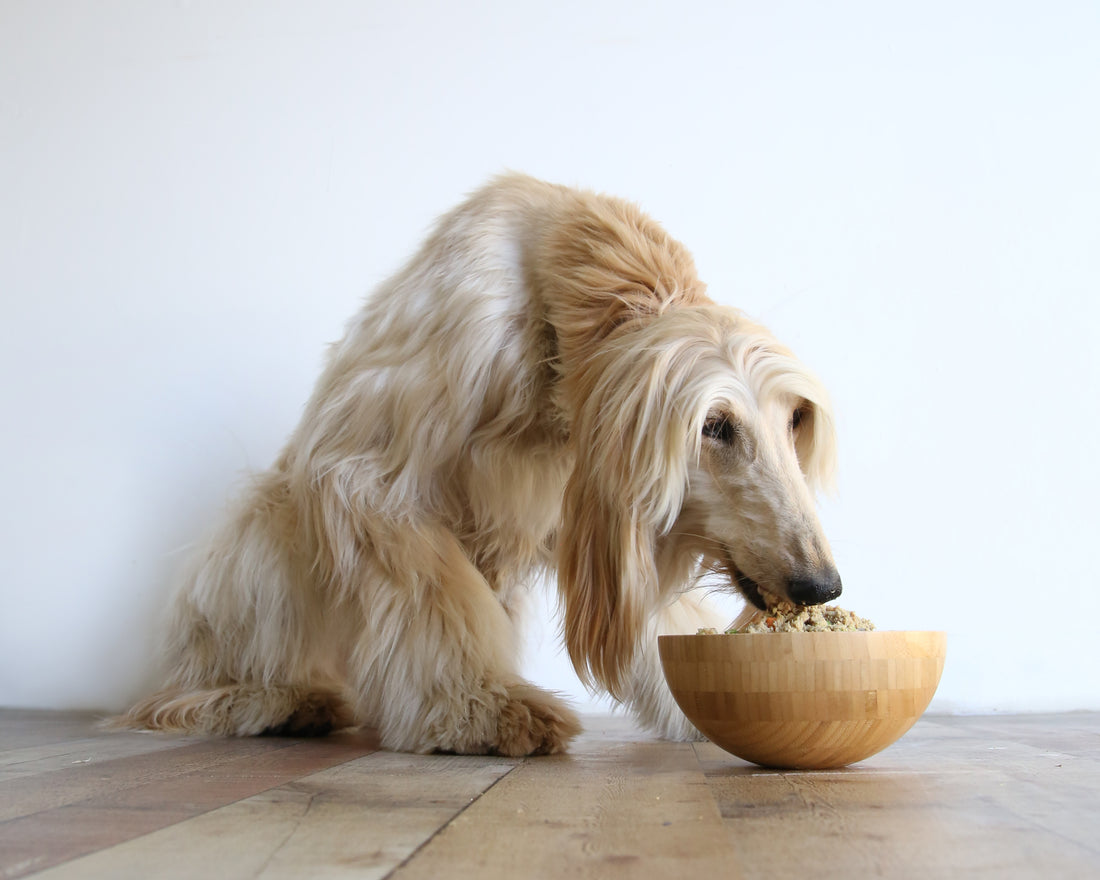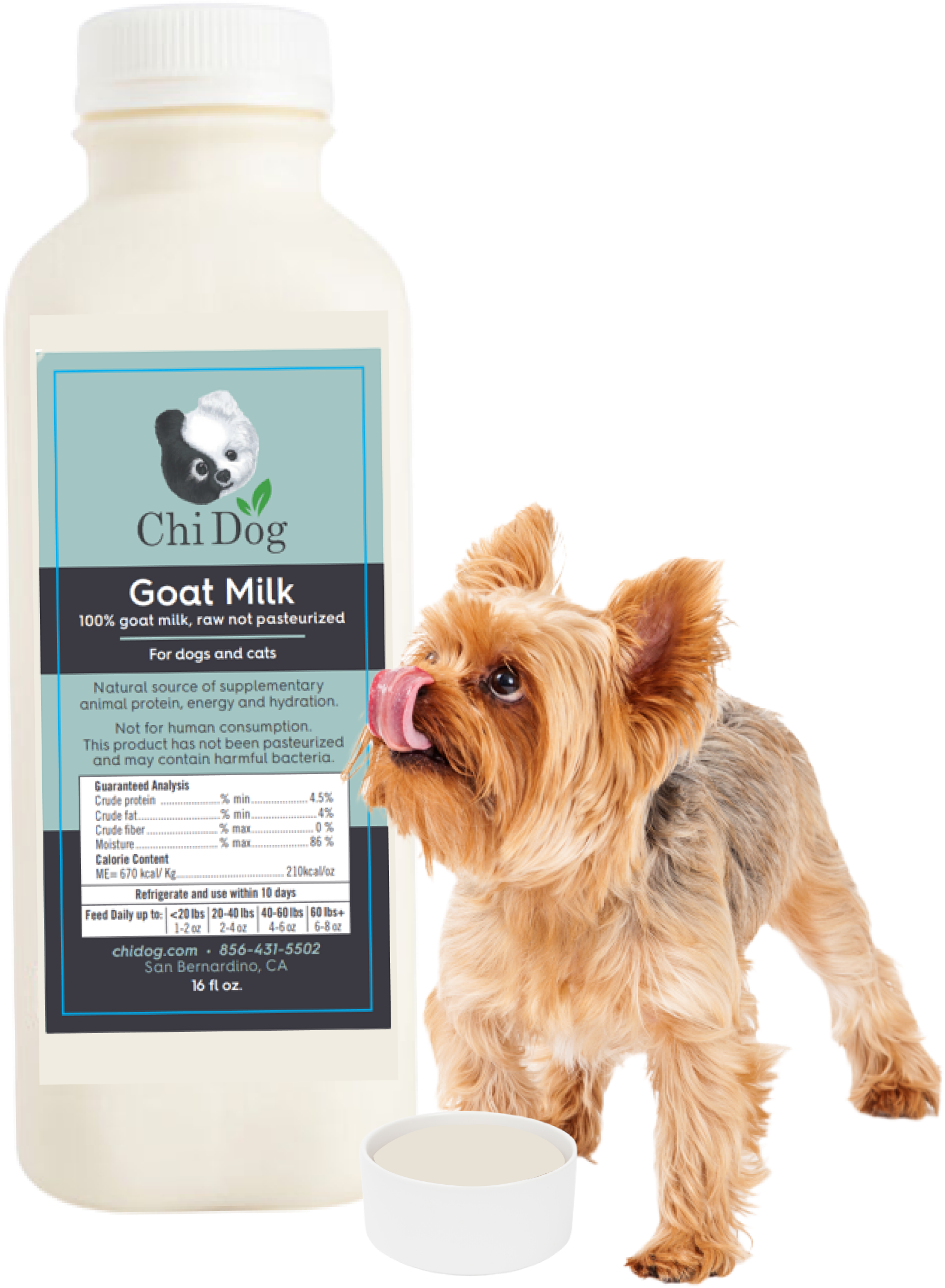
Cushing's Disease Dog Diet: The Best Food for Dogs With Cushing’s Disease


Watching your beloved dog struggle with Cushing's disease can be an emotionally draining experience. You may feel helpless seeing your energetic fur baby turn apathetic and suffer from symptoms that are both mysterious and worrisome.
But what if we told you that you could bring a significant change in your dog's life by choosing the right food? Nutrition is a powerful tool, especially when tackling complicated diseases like Cushing's. Following a Cushing’s diet for dogs can provide profound relief to your pet/
Here at Chi Dog, we've used veterinary science and traditional Chinese medicine principles to create the Fire Diet, which many believe is the best food for dogs with Cushing's disease. Once you see what a difference it can make in your pet’s life we’re confident you’ll agree.
Below, we'll demystify Cushing's disease, discuss why a proper diet for dogs with Cushing’s disease is so crucial, and make it crystal clear why the Fire Diet is a game-changer in a Cushing disease dog diet. Let us empower you to give your dog the life they deserve!
What is Cushing’s Disease?
First things first…what is Cushing’s disease? Before we can introduce you to the best food for dogs with Cushing’s disease, allow us to provide a bit of context as to what this condition is all about.
Definition and Types: Pituitary-dependent vs Adrenal-dependent
Cushing's disease, or hyperadrenocorticism, is a hormonal disorder that affects dogs. It results from excessive production of cortisol, a steroid hormone that plays a pivotal role in various physiological functions. There are two main types of Cushing's disease:
- Pituitary-dependent Cushing's Disease: Around 85% of cases belong to this category. Here, a benign tumor in the pituitary gland stimulates an overproduction of cortisol by the adrenal glands.
- Adrenal-dependent Cushing's Disease: This type is less common and is characterized by a tumor in one or both adrenal glands, which are located near the kidneys.
Understanding which type your dog has is crucial for effective treatment, including following a Cushing’s disease dog diet, which we'll discuss in depth later in this article
Common Symptoms: What to Look Out For
The symptoms of Cushing's disease can often mimic those of other ailments, making it a tricky condition to diagnose. Here are some of the common signs to look out for:
- Excessive thirst and urination
- Rapid weight gain or obesity
- Hair loss and thinning of the skin
- Increased panting and restlessness
- Pot-bellied appearance
Being alert to these symptoms can make a significant difference in early diagnosis and management, including implementing the right Cushing disease dog diet. But, because these symptoms can mirror other conditions, it’s important to start with a vet diagnosis.
Diagnosis and Testing: What Vets Typically Do
Diagnosis typically begins with a thorough physical examination and a detailed medical history. Your vet will likely recommend blood tests, urine analysis, and possibly an ultrasound to examine the adrenal glands.
Further tests like the ACTH stimulation test or the low-dose dexamethasone suppression test may be needed for a definitive diagnosis.
Understanding Cushing's disease, its types, and symptoms is crucial for any pet parent dealing with this condition. From there, you can start to gain a better understanding of how a Cushing’s diet for dogs may be able to help. That being said, let’s examine the role a Cushing disease dog diet plays in treatment.
The Role of Diet for Dogs with Cushing’s Disease

Medication is often the first thing that comes to mind when thinking of treating Cushing's disease. But did you know that diet can also play a pivotal role in managing this complex disorder?
In fact, the food your pet eats can either exacerbate or alleviate the symptoms, working hand-in-hand with medical treatments.
Before we talk about the best food for dogs with Cushing's disease and introduce you to our Cushing’s diet for dogs, we need to examine the link between diet and the condition.
Nutritional Imbalances: What Cushing's Does to Metabolism
Diet plays an important role in managing Cushing's disease, often more than most pet owners realize. One of the direct effects of the condition is its impact on your dog's metabolism.
Elevated levels of cortisol can lead to an imbalance in fat, protein, and carbohydrate metabolism.
This can result in weight gain and poor nutrient absorption, making the choice of the best food for a dog with Cushing's disease crucial.
The Importance of High-Quality Protein and Low Carbs
The quality of protein is paramount when it comes to crafting the best Cushing disease dog diet. It’s not just about getting enough protein, but protein from the right source.
Dogs with this condition are usually older and may have compromised liver or kidney function. High-quality protein sources like lean meats are easier to digest and metabolize, reducing the stress on these organs.
Additionally, reduced carbohydrate intake is advised as dogs with Cushing's disease often have elevated blood sugar levels. As you may be starting to realize, the best food for dogs with Cushing's disease is one high in protein and low in carbs. But, let’s see how anti-inflammatory foods fit into the puzzle.
The Need for Anti-Inflammatory Foods
Since Cushing's disease has a pro-inflammatory effect on the body, incorporating anti-inflammatory foods can bring much-needed relief.
Foods rich in omega-3 fatty acids like fish, flaxseeds, or specific fruits and vegetables can help manage inflammation. While these aren't a cure, they do support a more balanced system and can be an excellent complement to medication or other treatments your vet may recommend.
What is the Best Cushing’s Disease Dog Diet? Introducing the Best Food for Dogs With Cushing’s Disease at Chi Dog
When dealing with a complicated health condition like Cushing's Disease, you don't just want to manage symptoms - you want to improve your dog's quality of life. As pet owners, we often stand at crossroads when deciding what diet can best support our four-legged companions.
That's where Chi Dog comes into play. We offer more than just dog food - we provide a targeted nutritional approach to handle Cushing's Disease, specifically designed to work in synergy with any medical treatments your dog may be undergoing.
Here’s why you can count on us for the best food for dogs with Cushing’s disease…
Why You Can Trust Chi Dog for the Best Food for Dogs With Cushing’s Disease
Choosing a diet for a dog with Cushing's isn't merely about picking a brand - it's about entrusting a company with your pet’s well-being. Finding the right dog food for Cushing's disease is not something to take lightly. Fortunately, your search ends here. Chi Dog stands apart from the rest for several reasons:
- Veterinarian Formulated: Our recipes are crafted by veterinarians who specialize in dog nutrition and are well-versed in managing Cushing's Disease.
- Quality Ingredients: We source only high-quality, natural ingredients that are beneficial for dogs with Cushing's disease.
- Personalized Plans: Our team offers one-on-one consultations to tailor your pet's diet plan, adjusting as needed to meet unique nutritional needs.
- Traditional Chinese Medicine Approach: At the core of Chi Dog is the philosophy of TCM, which aims to create bodily harmony by balancing yin and yang, and regulating Qi (life force).
- USDA Certified Kitchen: Our recipes are crafted in a USDA Certified kitchen, ensuring that your dog receives food that adheres to the highest safety and quality standards.
- AAFCO Compliance: Chi Dog not only meets but often exceeds the nutritional guidelines established by the Association of American Feed Control Officials (AAFCO)
And, of all the holistic dog food we offer, there is one diet that we consider to be the best Cushing’s diet for dogs: the Fire Diet.
The Fire Diet: The Best Cushing’s Diet for Dogs
Drawing upon the wisdom of Traditional Chinese Medicine (TCM), the Fire Diet addresses the very imbalances that Cushing's Disease can wreak on your dog's system. Let's break down why this diet is uniquely suited for managing this condition:
- Anti-Inflammatory Properties: Cushing's Disease often brings along a host of inflammatory issues, from skin conditions to digestive problems. The Fire Diet is designed to be inherently anti-inflammatory, working to counteract the chronic inflammation often observed in dogs with Cushing's.
- High-Quality Protein: Cushing's Disease can take a toll on your dog's muscle mass, making the quality of protein all the more critical. Our Fire Diet features turkey as its primary protein, a lean meat that’s easier to digest and metabolize.
- Low Carbohydrate Content: The Fire Diet features a mere 7% carbohydrates, which can be extremely beneficial for the insulin resistance often accompanying Cushing's Disease.
- Cooling Foods for Excess Heat: Cushing's Disease can create what TCM describes as 'Excess Heat.' The ingredients in the Fire Diet, like edamame and broccoli, are carefully chosen to provide a cooling effect on the body, aiding in restoring balance.
- Nutrient Density: With ingredients like carrots, which offer natural antioxidants, and millet, a gluten-free grain rich in fiber, the Fire Diet aims to fill the nutritional gaps that Cushing's can create, rounding out its strategy to be your dog's best defense.
The best part? Your dog is going to LOVE their new Cushing’s disease dog diet. They’ll look forward to mealtime and leave an empty bowl each time.
It’s also the best IBD dog diet, the best dog food for anxiety, the best dog diet for skin allergies, and even the best diet for dogs with pancreatitis. That being said, here are some tips on transitioning your pet to their new Cushing disease dog diet.
Tips for Transitioning Your Pet to Their Cushing Disease Dog Diet
Transitioning your dog to a new diet is a crucial step that could significantly affect their comfort and wellbeing, especially when dealing with Cushing’s Disease.
The Fire Diet is designed to be as gentle as it is effective, but a thoughtful introduction is key to your pet’s adjustment. Here's how to make that transition smooth and stress-free:
- Phase-in Period: Start by mixing about 20% of the Fire Diet with your dog's existing food. Gradually increase this percentage every 2-3 days.
- Monitor and Adjust: Keep a close eye on your dog’s response. Look out for signs like a change in bowel movements, energy levels, or skin condition. The beauty of the Fire Diet is its ability to address these symptoms, but any adverse reactions should prompt an immediate visit to the vet.
- Hydration: As you make the switch, remember that the Fire Diet has a lower moisture content compared to many commercial dog foods. Ensure that your dog has consistent access to fresh water.
- Consult Your Vet: It’s always a wise decision to consult with your veterinarian when making significant dietary changes, particularly when managing a condition as delicate as Cushing's Disease.
Now, just as you should feed your pet the best dog food for Cushing's disease, there are foods to avoid with Cushing’s disease dog. If you follow our dog Cushing’s diet you won’t have to worry about this, but it’s worth being aware of these.
Foods to Avoid With Cushing’s Disease Dog
While the Fire Diet has been formulated to include all the beneficial ingredients your dog needs, it's equally important to know what to avoid. Certain foods can exacerbate the symptoms of Cushing’s Disease or interfere with the treatment regimen.
- High-Glycemic Foods: Foods like corn, potatoes, and rice can spike your dog's blood sugar levels, complicating the management of Cushing’s Disease.
- Saturated Fats: These can heighten inflammation and contribute to weight gain, a significant concern in managing Cushing’s Disease.
- Processed Foods: Processed meats, sugary treats, and foods with artificial colors or preservatives can result in hormonal imbalances and heighten the symptoms of Cushing’s Disease.
- High Sodium Foods: Excessive salt can lead to elevated blood pressure and make Cushing's symptoms worse.
- Human Snacks: A lot of human foods, especially sweets and spices, can upset your dog’s stomach and skew the well-balanced nutrition provided by the Fire Diet.
By steering clear of these harmful foods and carefully transitioning to the Fire Diet, you're giving your dog a fighting chance against Cushing's Disease. You’re not just changing their diet; you’re potentially transforming their quality of life.
What Else Can Pet Parents Do Aside From Feeding the Best Dog Food for Cushing’s Disease?

Navigating the complexities of Cushing's disease in dogs requires a comprehensive approach, beyond just selecting the right Cushing’s diet for dogs. Let's delve into some other strategies you can employ to manage your pet's health more effectively.
Medical Treatments: Common Medications and Their Side Effects
- Trilostane: Commonly used medication that inhibits cortisol production. While effective, it can cause side effects like lethargy and gastrointestinal issues.
- Mitotane: Another medication that suppresses adrenal function but comes with its own list of side effects, including nausea and weakness.
- Regular Vet Visits: Frequent check-ups are crucial for monitoring medication effectiveness and adjusting doses.
Alternative Therapies: Acupuncture, Herbal Remedies
- Acupuncture: Known to improve circulation and reduce inflammation, it can be a complementary treatment to medication.
- Herbal Remedies: Plants like milk thistle and dandelion can support liver function, but always consult your vet before introducing new herbs.
- CBD Oil: Some owners have found it useful for symptom management, though more research is needed.
Lifestyle Changes: The Role of Exercise and Stress Management
- Regular Exercise: Light, consistent exercise can help combat muscle atrophy and maintain a healthy weight.
- Stress Management: Dogs with Cushing's are often more susceptible to stress. Consider calming techniques like soft music or a cozy sleeping environment.
- Scheduled Feeding: Consistent feeding times using high-quality food such as the Fire Diet can help regulate cortisol levels, complementing medication for a comprehensive Cushing’s disease dog diet.
Following these tips along with the best Cushing’s disease dog diet creates a robust management plan that gives your dog the best shot at a comfortable, fulfilling life.
So, let’s bring this conversation on the best dog food for Cushing's disease to a close so you can place your order for the Fire Diet today!
Parting Thoughts on Cushing’s Disease Dog Diet
Managing Cushing's disease in your dog is a multifaceted challenge that extends beyond medication. The role of a balanced, specially-formulated diet like the Fire Diet cannot be overstated.
Coupled with other treatment modalities such as medication and alternative therapies, the right food choice lays the foundation for a more comfortable, healthier life for your beloved pet.
Learn more about how Chi Dog food can address other problems and conditions in dogs in our blog. We have resources on topics like the best diet for overweight dogs, the best dog cancer diet, or the best diet for dogs with liver disease.
Don't leave your dog's health to chance. Make an informed choice today and transition to the Fire Diet for comprehensive care for Cushing’s disease today!
_________________________________________________________________________
About the author
Dr. Susan Bohrer has been a practicing veterinarian for 15 years teaching home cooking techniques to clients. Dr. Bohrer is Certified in Traditional Chinese Veterinary Medicine’s Herbal Therapy, Acupuncture and Food Therapy.
Download PDF here



